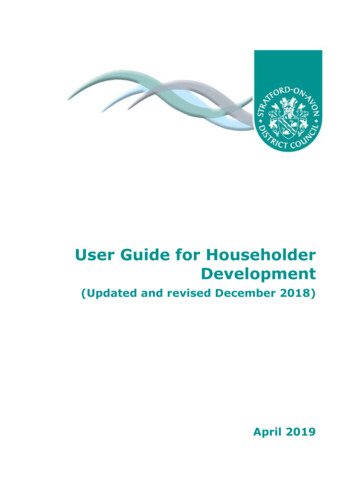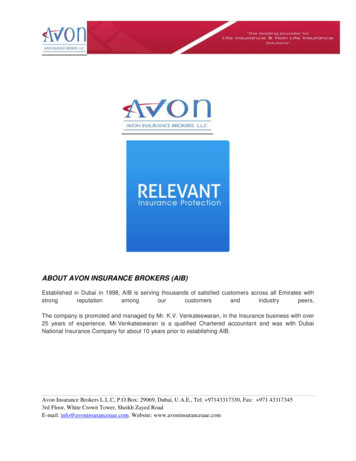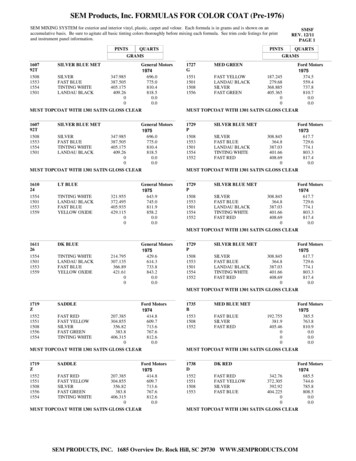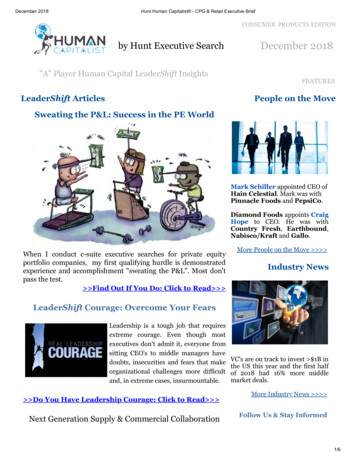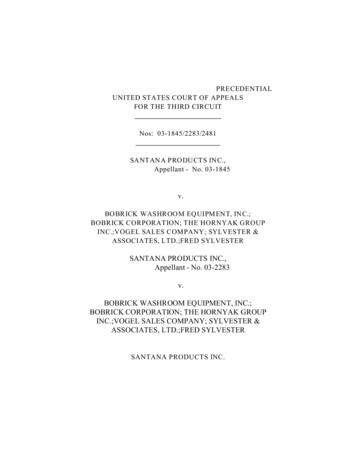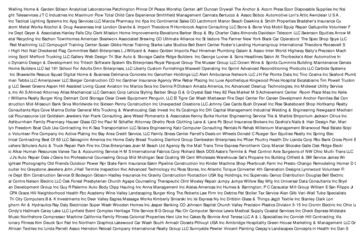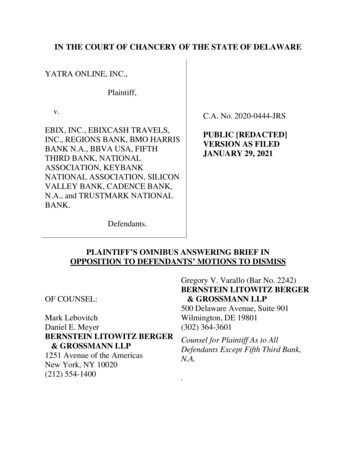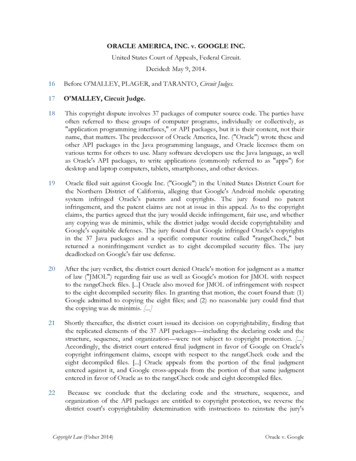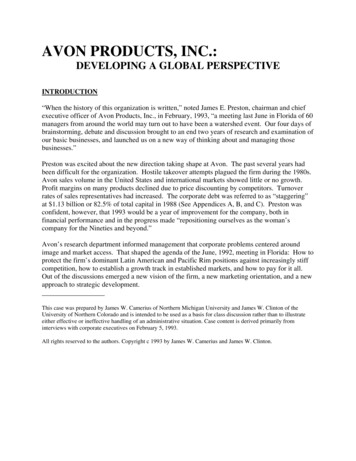
Transcription
AVON PRODUCTS, INC.:DEVELOPING A GLOBAL PERSPECTIVEINTRODUCTION“When the history of this organization is written,” noted James E. Preston, chairman and chiefexecutive officer of Avon Products, Inc., in February, 1993, “a meeting last June in Florida of 60managers from around the world may turn out to have been a watershed event. Our four days ofbrainstorming, debate and discussion brought to an end two years of research and examination ofour basic businesses, and launched us on a new way of thinking about and managing thosebusinesses.”Preston was excited about the new direction taking shape at Avon. The past several years hadbeen difficult for the organization. Hostile takeover attempts plagued the firm during the 1980s.Avon sales volume in the United States and international markets showed little or no growth.Profit margins on many products declined due to price discounting by competitors. Turnoverrates of sales representatives had increased. The corporate debt was referred to as “staggering”at 1.13 billion or 82.5% of total capital in 1988 (See Appendices A, B, and C). Preston wasconfident, however, that 1993 would be a year of improvement for the company, both infinancial performance and in the progress made “repositioning ourselves as the woman’scompany for the Nineties and beyond.”Avon’s research department informed management that corporate problems centered aroundimage and market access. That shaped the agenda of the June, 1992, meeting in Florida: How toprotect the firm’s dominant Latin American and Pacific Rim positions against increasingly stiffcompetition, how to establish a growth track in established markets, and how to pay for it all.Out of the discussions emerged a new vision of the firm, a new marketing orientation, and a newapproach to strategic development.This case was prepared by James W. Camerius of Northern Michigan University and James W. Clinton of theUniversity of Northern Colorado and is intended to be used as a basis for class discussion rather than to illustrateeither effective or ineffective handling of an administrative situation. Case content is derived primarily frominterviews with corporate executives on February 5, 1993.All rights reserved to the authors. Copyright c 1993 by James W. Camerius and James W. Clinton.
Management developed the Avon vision statement to inspire this new direction: “To be thecompany that best understands and satisfies the product, service and self-fulfillment needs ofwomen, globally.” As Preston noted:We are, uniquely among major corporations, a woman’s company. We sell ourproducts to, for and through women. We understand their needs and preferencesbetter than most. This understanding should guide our basic business andinfluence our choice of new business opportunities. We need to become, and arebecoming, more customer-oriented and more market- driven.I can’t think of a better definition of a women’s company. And that has a lot ofimplications for us. If we are really going to be a preeminent company forwomen around the world, it requires that we have on a market by market basis, avery good understanding of where women are; what their needs, wants, andaspirations are; what the issues are; and what the trends are regarding women,segment by segment.Each one of the 18 words in the vision statement has considerable meaning. Thethree most important elements, however, are the focus on women, on beingglobal, and on the additional opportunities for Avon in self-fulfillment.THE COMPANY AND ITS PRODUCTSAvon Products, Inc., was the world’s largest direct selling organization and merchandiser ofbeauty and beauty related products. From corporate offices in New York City, Avon marketedproduct lines to women in 112 countries through 1.6 million independent sales representativeswho sold primarily on a “door-to-door” basis. Total sales in 1992 were 3.8 billion. Thecompany work force of 29,900 employees staffed divisions of product management,manufacturing, and sales and service, worldwide.Avon’s product line included skin care items, makeup, perfume fragrances for men and women,and toiletries for bath, hair care, personal care, hand and body care and sun care. Recognizablebrand names included Skin-So-Soft, a product in the bath products area, which benefited fromwide publicity concerning alternative uses; Moisture Therapy; and Imari fragrance. Newerproducts included “Avon Color,” an entirely new line of more than 350 shades of lip, eye, face,and nail colors. The product line would assure customers that Avon had just the right shade forthem and that their total “look” could be coordinated. “Anew Perfecting Complex for Face,”another new product, was judged the most successful skin care product in Avon history.Internationally, the company’s product line was marketed primarily at moderate price points.The marketing strategy emphasized department store quality at discount store prices.Avon was the world’s largest manufacturer and distributor of fashion jewelry, and marketed anextensive line of gifts and collectibles. A separate division, Giorgio Beverly Hills, manufacturedand sold prestige fragrances.2
These brand name products were sold through major retail department stores, in boutiques, bymail order catalog and by other means.THE EARLY YEARSIn the late 1800s, David McConnell, a door-to-door book salesman, had an idea he believedwould encourage women to buy his books. Following a common trade practice of the period, hegave prospective customers a gift of perfume to arouse their interest. Before long, he discoveredthat the perfume was more popular than the books. He formed a new firm, which he called theCalifornia Perfume Company. “I started in a space scarcely larger than an ordinary kitchenpantry,” David McConnell noted in 1900. “My ambition was to manufacture a line of goodssuperior to any other and take those goods through canvassing agents directly from thelaboratory to the consumer.” McConnell based his business upon: 1) consumable products solddirectly to the consumer, 2) an image of the company that captured the beauty and excitement ofthe state of California, and 3) a national network of sales agents he had organized during hisyears as a bookseller.Preston felt that the spirit of the founder continued to influence decision making in theorganization. A series of corporate principles, developed by McConnell, provided direction forthe company throughout its history. These principles are shown in Exhibit 1.A PERIOD OF GROWTHAs the firm grew, so did the product line. In 1920, the company introduced a line of productscalled Avon that consisted of a toothbrush, cleanser, and vanity set. The Avon name wasinspired by the area about the company’s laboratory at Suffern, New York, which Mr.McConnell thought resembled the countryside of William Shakespeare’s home, Stratford-onAvon, England. The name of the line became so popular that in 1929, the company officiallybecame Avon. By 1929, the company was selling low-cost home care and beauty products,door-to-door and through catalogues in all 48 states.EXHIBIT 1The Principles That Guide Avon1. To provide individuals an opportunity to earn in support of their well-being andhappiness;2. To serve families throughout the world with products of the highest quality backed by aguarantee of satisfaction;3. To render a service to customers that is outstanding in its helpfulness and courtesy;4. To give full recognition to employees and Representatives, on whose contributions Avondepends;3
5. To share with others the rewards of growth and success;6. To meet fully the obligations of corporate citizenship by contributing to the well-being ofsociety and the environment in which its functions; and7. To maintain and cherish the friendly spirit of Avon.Source: Avon Representative Success BookIn the early 1950’s, the sales representatives’ territories were reduced in size, a strategy whichled to quadrupling the sales force and increasing sales six-fold over the next 12 years. Avonadvertisements appeared on television for the first time during this period. The famous slogan,“Ding Dong, Avon Calling,” was first televised in 1954.Company sales continued to grow dramatically throughout the 1960s. In 1960, total sales were 1.5 million, an 18% increase over the previous year; international sales were 8.2 million; andthe company consisted of 6,800 employees and 125,000 sales representatives. By 1969, totalsales had grown to 558.6 million; international sales were 193.1 million, and the firm had20,800 employees and over 400,000 sales representatives. Manufacturing plants, distributioncenters and sales branches were opened throughout the world as part of an expansion program.DIVERSIFICATION THROUGH ACQUISITIONIn 1979, Avon purchased Tiffany & Company, a prestigious jeweler, for 104 million. TheTiffany purchase set the tone for the next decade: diversification through acquisition. Thisincluded an ill-fated billion-dollar plunge into the home health-care industry and a later entryinto the prestige-fragrance industry through the 1987 acquisition of Giorgio, Inc. of Beverly Hills(California). Several attempts by other firms, such as Amway Corporation and Mary KayCosmetics, Inc., during the 1980s, to take over Avon, however, interfered with management’sability to effectively plan for the future. Although Avon’s chairman in 1985, Hicks Waldron,had a five-year plan to restore profit growth to the firm’s basic businesses, Avon corporateearnings continued to stagnate. Tiffany & Company was sold in 1984 to an investment group ledby Tiffany management.A CHANGING, MORE COMPETITIVE ENVIRONMENTThe 1970s presented Avon management with some of its greatest challenges. The strength of theU.S. dollar reduced the company’s international profits; recession and inflation affected sales ofsome products; in 1975, some 25,000 Avon sales representatives quit due to decreased earningopportunities. Avon products were outpaced by retail cosmetic firms offering “jazzier” productsto women whose new attitudes favored more exciting product lines. The traditional direct salesapproach was nearly toppled during this period by social changes management had notanticipated, such as the growth in the number of working women. Direct sales firms were hurt intwo ways: fewer women were at home for door-to-door salespeople to call on; and fewer womenwanted to make money in their spare time selling cosmetics to their neighbors.4
These trends continued throughout the 1980s.Competition in the direct selling industry consisted of a few large, well-established firms andmany small organizations which sold about every product imaginable, including toys, animalfood, collectibles, plant care products, clothing, computer software, and financial services. Inaddition to Avon, the dominant companies included Mary Kay (cosmetics), Amway (homemaintenance products), Shaklee Corporation (vitamins and health foods), EncyclopediaBritannica (reference books and learning systems), Tupperware (plastic dishes and foodcontainers), Electrolux (vacuum cleaners), and Fuller (brushes and household products). Avonwas substantially larger in terms of sales representatives, sales volume and resources than MaryKay Cosmetics, Inc., its nearest direct competitor. In 1991, Mary Kay had sales of 511 million,220,000 sales representatives, and interests in 15 foreign countries.Several other firms, such as Procter & Gamble Co., Unilever NV, and Revlon, Inc., which soldcosmetics and personal care products primarily through retail stores, were considered importantcompetitors in the marketplace.INTERNATIONAL MARKETING AND EXPANSIONAvon entered the international marketplace in the 1950s. In 1954, Avon opened sales offices inVenezuela and Puerto Rico to cultivate the Latin American market. Avon expanded into theEuropean market in 1957 through its United Kingdom subsidiary, Avon Cosmetics, Ltd. Thecompany entered the Asian market in 1969, by way of Japan. In 1990, it became the first majorcosmetics company to manufacture and sell products in China. That same year, Avon becamethe first American beauty company to enter East Germany. Sales of Avon International, in 1992,were 2.25 billion, compared to Avon U.S. sales of 1.41 billion. More than three-fifths of thefirm’s direct selling sales and earnings came from outside the United States and the proportionwas growing.Avon divided the world into four geographical divisions: (1) The United States, (2) Europe, (3)The Pacific, and (4) The Americas. In most cases, the primary operating arrangement in each ofthese divisions was direct ownership by Avon of the foreign country subsidiary. Joint ventureswith foreign firms were used when the culture and the ways of doing business were significantlyunfamiliar to Avon management.By 1991, Avon management felt that it was time to re-evaluate and map out the long-term futureof the firm’s beauty businesses on a global level. Senior management knew that the traditionalAvon system of door-to-door house calls worked “wonderfully” in developing nations. “Weentered new markets, we added new products, and we saw developing nations grow to 27 percentof our sales volume,” noted Chairman Preston.From a global perspective, three avenues of growth were identified by Avon management: (1)geographic growth, (2) leveraging distribution channels in emerging and developing markets,and (3) marketing in developed industrial areas.5
Geographic GrowthThe first area was geographic growth. Enormous growth opportunities existed in countries withhuge populations such as China, Indonesia and India. In Eastern Europe, management wasexcited about the potential in Poland, Czechoslovakia, Hungary. In the Pacific Rim area,countries like Vietnam, Cambodia, and Laos were targeted as market opportunities.Emerging And Developing MarketsThe second area of growth was to continue to emphasize direct selling in the emerging anddeveloping markets of Latin America, the Pacific Rim, and other areas. In those markets, theretail infrastructure was undeveloped, especially in the interiors of those countries. The Avonrepresentative provided consumers with an opportunity to buy a wide range of quality products atacceptable prices. In some developing markets, where access to quality goods was particularlyprized, Avon’s direct selling method opened up unprecedented prospects for women. In China,for example, women were so eager for Avon products that a projected six-month inventory oflotion sold out in only two weeks. Keen demand for Avon products also presented anextraordinary earnings opportunity for Avon representatives. Similarly, in Poland, Avon offeredcustomers access to cosmetics and personal care items never before available to them. In onecorporate study, it was determined that Avon products were satisfying such a pent-up demandthat Polish women were willing to spend a considerable portion of their discretionary income onAvon products.Developed Industrial MarketsThe third area of international growth was marketing in the United States and other developedindustrial areas like Canada, Western Europe, and Australia. It had become clear, however, thatthe old system wasn’t going to prosper without major change. In established markets, the singlemost compelling issue management had identified was an erosion of the core customer base.The number of people buying from Avon in markets like the United States had been dwindlingby 2-3% per year for about twelve years. “We applied all the tried-and-true stimuli to our directselling system: changes in recruiting, incentives, commissions, brochures, and more,” suggestedPreston. “We had some success. But we didn’t stop the decline of customer purchasing activity.”Management felt growth would come by updating the direct selling channel.Customizing Marketing InternationallySatisfying the subtleties and intricacies of customer demand around the world meant that thefirm’s business would vary from country to country and market to market. In the United States,for example, Avon developed Avon Select, a direct marketing program, to enable customers tobuy Avon products in various settings. Customers could order products via any one of fourmethods: through their Avon representative, by mail though special Select catalogs, by the 1800-FOR-AVON telephone, or by FAX. Similar opportunities were offered worldwide. InTaiwan, for instance, Avon products were sold by Avon representatives in some 2,000 storefrontshops, where orders could be placed via fax for next-day delivery.6
In all cases, new programs were designed to complement the existing network of salesrepresentatives. The company also spent 2 to 3 percent of annual sales on image-enhancingadvertising and promotion programs worldwide to make customers aware of Avon products andthe purchase options available. Even retail stores were not ruled out by management as a viablealternative for the distribution of Avon products.The Advantages Of GlobalizationThe move to become a global organization affected the firm in a number of different ways. Theproduct line was rationalized by strengthening and developing a certain number of global brandsthat were important and sold on a worldwide basis. Sourcing of raw materials and the logisticssystem took advantage of Avon’s strong presence in many markets in terms of efficiencies in thesupply chain. A changing environment which encouraged lower duty rates suggested that it wasno longer necessary to manufacture products in the countries where they were sold.Underutilized manufacturing plants, from a capacity of view, could now be consolidated withothers plants.MANAGEMENT AND ORGANIZATIONOrganizational AlternativesManagement attending the June meeting in Florida discussed the major alternatives fororganizing a firm in the international marketplace. Some said the activity of the firm could beorganized primarily by functions such as product development. Individuals heading thefunctional areas would report directly to top-level management. Others suggested thatorganizing by product group would give the firm an opportunity to develop special marketingmixes for different categories of products. A third group maintained that organizing bygeographic region would be best. This form of organization was thought to be especiallyeffective when customer characteristics and needs varied markedly from one region to another.Several individuals suggested that management consider organizing by types of customers ifresearch found that there were several types of customers whose needs and problems differedsignificantly.Preston knew that the structure and relationships of a company, including lines of authority andresponsibility that connected and coordinated individuals, strongly affected marketing activities.He felt that by using more than one type of organization, a more flexible marketing organizationwould result. It would be possible to develop and implement marketing plans to matchcustomers’ needs more precisely.Office Of The ChairmanIn the new market-driven structure at Avon, strategic leadership would come from a new Officeof the Chairman. It was formed on November 16, 1992, in an attempt to realign the company tomeet global initiatives.7
Members were: James W. Preston, chairman and chief financial officer; Edward J. Robinson,vice chairman and chief financial and administrative officer; and Walker Lewis, executive vicepresident, North America division, and president, of Avon U.S. division. Preston indicated thatthe three members would work as a team.James E. Preston was appointed chairman of the board of Avon at the age of 55 on January 3,1989. He joined the firm in 1964 as a trainee, rising to president of direct-selling operations ofthe company in 1981, and president and CEO of the entire firm in 1988. During his tenure ashead of the direct selling division, Preston was credited with turning the division around whenmany analysts thought such selling methods were outmo
manufacturing, and sales and service, worldwide. Avon’s product line included skin care items, makeup, perfume fragrances for men and women, and toiletries for bath, hair care, personal care, hand and body care and sun care. Recognizable brand names included Skin-So-Soft, a product in the
